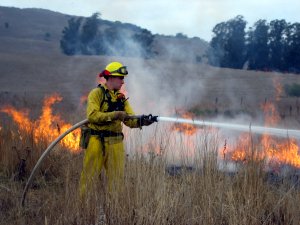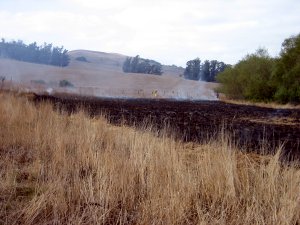 Restoration burn at Dunham Elementary School, Petaluma.
Restoration burn at Dunham Elementary School, Petaluma.
A little over a month ago, my partner and I were driving home one evening when, off in the distance, we spotted a huge column of smoke rising into the sky. We exchanged nervous glances; it appeared to be originating from somewhere uncomfortably close to our neighborhood.
We arrived home to find our apartment safe and sound, but from our window we had a clear view of the hill just opposite us as smoke gushed from its top. As we watched, a line of flames crested the hill and started down the nearside, headed swiftly toward the homes in its path. As daylight faded, the dancing orange flames were joined by the blinking lights of emergency vehicles evacuating neighboring streets, and then by the hum of helicopters and planes delivering water. Amazingly, the night ended with only about 35 acres burned and no houses damaged.
Like a lot of Americans, I grew up on Smokey Bear and a cultural perception of wildfires as scary, destructive, and somehow unnatural. And they can be (the fire we witnessed is believed to have been human-caused). But did Smokey give us the whole story?
In many places -- especially California -- fire has always been part of the landscape, a key player in the cycling of nutrients and the process of succession. In recent years, scientists studying fire ecology have developed a greater understanding of how many species have adapted to survive and even exploit fire disturbances, how a century of fire suppression policy may have had unintended consequences for some ecosystems, and even how fire can be used as a restoration tool.

